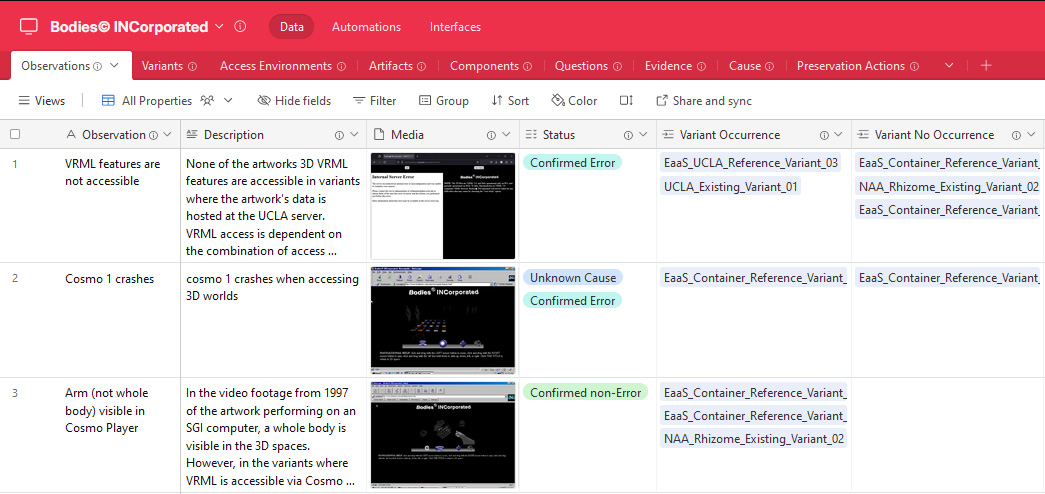Nicole Savoy’s MA-thesis introduces a groundbreaking method for evaluating the condition of net artworks with the help of Emulation as a Service (EaaS), using Victoria Vesna's Bodies© INCorporated (1996-99) as a case study. The artwork exemplifies many challenges conservators are faced with in the field of digital art and net art, including lack of documentation, heavy use of obsoleted technologies, collaborative creation, complex interactions that allow user contributions, a narrative practice that blends ideas presented as pure concepts with ones that have been technically implemented, and most importantly, an extended temporal distance in between the work being developed and it being researched for conservation.
Bodies© INCorporated developed out of Victoria Vesna’s 1995 project Virtual Concrete. Virtual Concrete was the artist’s first response to the body in relation to the Internet and online databases. The artwork explored the relationship between virtual disembodied experience, real tangible experience, and communication. Bodies© INCorporated furthers this concept of creating real and virtual bodies in the realm of cyberspace, using interactive 3D graphics, and allowing users to construct new, sometimes bizarre, new-agey humanoid bodies by filling out a form on the website. Currently, Bodies© INCorporated can be accessed online at its University of California, Los Angeles (UCLA) URL, http://www.bodiesinc.ucla.edu/, or on Rhizome’s Net Art Anthology (NAA) website in an emulator, https://sites.rhizome.org/anthology/bodiesinc.html.

In the context of the thesis, the term “variant” was established: A variant constitutes the (identical) artwork’s data within a specific software environment. Depending on a variant's unique software environment configuration, the same data may appear and act differently.

The UCLA site, made by the artist herself, is the main variant and access point for the work on its original server. As the technology of the Web evolved, the UCLA server was routinely updated, and many of the work’s features became inaccessible and got replaced with error pages in contemporary browsers.
The NAA variant was created by Rhizome using a period-adequate browser with the necessary plugins within Emulation as a Service (EaaS). This emulated NAA variant performs more of the site’s features and functions, allowing users to experience the work more deeply. This is true in particular for the project parts implemented with VRML, “Virtual Reality Modeling Language,” a long-abandoned web standard that required dedicated, now obsolete browser plugins to render interactive 3D graphics.
Complicating matters further is the scarce documentation surrounding the artwork's active period, often muddled with misleading information. Vesna and her collaborators' experimental approach to production, entwined with fast-evolving technologies at the time, resulted in numerous reported features that were conceptualized but never implemented in the artwork's final composition. This ambiguity, compounded by the lack of clear and comprehensive references like video recordings or textual descriptions, posed a significant challenge to assessing the condition of the artwork.

Nicole Savoy’s newly developed condition reporting approach takes these challenges into account and compares observed artwork performances as they occur in different software environments. The devised workflow involves three stages. In the first stage, evidence of the artwork’s intended performance is gathered from sources including its existing publicly accessible variants (UCLA and NAA variants), literature, artist interviews, and data analysis. In the second stage, reference variants are built in EaaS based on the information collected in the first stage. These new environments contained different browsers, versions of plugins, and operating systems, easily managed and switched between using the affordances of EaaS. The third stage involves comparing the performances of existing and reference variants, and documenting observations in a relational database.
Building and comparing variants as a methodology for condition reporting proved to be well suited for Bodies© INCorporated. By accessing and observing the work in different technical environments, the intended and unintended performances of its components became evident. The use of EaaS as a condition assessment tool was an essential part of the workflow as it provided a platform for the creation and testing of reference variants. The ability to easily tweak and adjust the reference environments allowed testing the effects of specific changes to the artwork’s performance, enabling conservators to piece together a comprehensive understanding of an artwork’s intended state.
Finally, the use of a relational database allowed dynamic and easy documentation of observations linked to specific variants and components of the work. For this project, the relational database was implemented in notion and AirTable, and can be reproduced with open-source tools like nocodb or personal information management systems such as Obsidian. Using a relational database to manage all components of the workflow—observations, evidence, causes, artwork components, questions, and preservation actions—can support a scientific approach to condition reporting and preservation planning for digital art that is applicable to different types of interactive artworks and can be expanded to work as an institutional knowledge base for artworks exhibiting similar issues. Moreover, it shows that the complexity of multi-variant artworks requires specialized expertise, approaches, workflows, and tools to effectively meet their preservation needs.





























































































































